WW1 Diary
31st May 1919 Saturday
Young Man, There’s no Need to Feel Down
All material produced or reproduced here and throughout this work is the sole copyright of the author and the family of Doctor D.C.M. Page MC
“On Saturday night, May 31st, we gave our concert show in the large Y.M.C.A. Hall, Archangel. We had an excellent audience of over 600 troops, who showed their appreciation of our efforts in no uncertain way. It was a great success.”
Find out about our connection with Dr Page and an introduction to his diary here
29th May 1919 Thursday
Brass Hats. Only Here for the Beer?
All material produced or reproduced here and throughout this work is the sole copyright of the author and the family of Doctor D.C.M. Page MC
“On Thursday, May 29th, I visited Archangel for the first time since the arrival of the Relief Force. The streets were crowded with the new troops, who seemed to me to be a smart lot. Any number of Brass Hats were to be seen. I suppose they have just come out for the sea voyage, and shall depart for Blighty in a few days (as a matter of fact many of them did go back to England after only spending a few days in North Russia). I met Col. Crombie, R.A.M.C. of Edinburgh who has come out as Medical Consultant to the Force.”
Find out about our connection with Dr Page and an introduction to his diary here
26th & 27th May 1919 Monday and Tuesday
Have you any Beer?
All material produced or reproduced here and throughout this work is the sole copyright of the author and the family of Doctor D.C.M. Page MC
“However, the first of the Relief Force did come eventually on Monday, May 26th, 1919. Three huge transports – Czar, Cazarina and Stephen – passed our hospital during the forenoon packed with troops. We all rushed down to the river side which was crowded with Russian civilians. A lot of cheering was indulged in and bands played on board the ships. A lot of back-chat took place between our men and those on board the transports, such as: ‘Have you any beer?’ ‘What is Blighty like?’ etc. It was a great night, and it did us all a lot of good.
That night the Pierrot troupe which Q.M.S. Freeman and I have been training for the last fortnight gave its first performance in the Y.M.C.A. hut at Solombola. The place was packed, and there were many officers present from Archangel. The show went off very well, and we had a tremendous reception. We didn’t finish till 10.30 p.m. owing to having so many encores – a three hours’ show.
The newly-arrived British troops had a triumphal march through the streets of Archangel on the 27th May, and were very enthusiastically received by the Russian population. Flags were flying and great crowds lined the streets. Banners were displayed bearing the words – ‘Welcome to the British’, A Friend in Need is a Friend Indeed’ etc. It seems that no American flags were in evidence, and that the Yanks out here are annoyed at this.”
Whilst wiling away the long hours on the ships as they slowly made their way north and east towards Archangel you may wonder what conversations may have taken place. Let me save you some time in pondering. The young troops whose journey would not have been the hazardous voyage endured by the men they were being sent to relieve would have two pressing concerns. Would there be any beer and what would it be like? Followed by what would the girls be like? On arrival the convoy was met by General Ironside who went by boat to greet them. He was immediately confronted by the yelled question down from those aboard ‘Is there any beer?’ Those ships consisted of three large transports the SS Stephen, the HMTS Czar and also HMTS Tsarina/Czaritza. They had left Woolwich in London between the 11th and 13th May some calling at Newcastle to pick up extra men. Following some delay caused by the ice still in the White Sea they eventually made their way up the Dwina for a much anticipated welcome.
![]()
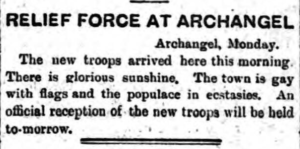
Image © britishnewspaperarchive.co.uk
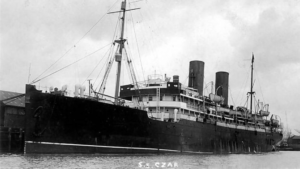
This is SS Czar built in Glasgow in 1912
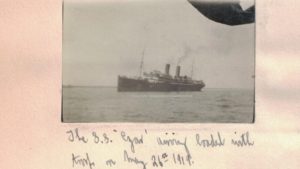
The SS Czar arriving loaded with troops on May 26th 1919
Originally launched on 23rd March 1912, Czar was a passenger/cargo ship of 6503 tons. She was built for the Russian American Line but requisitioned by the Royal Navy before entering service.
During WW1 she was used between New York and Archangel and following the Armistice was decommissioned only to be immediately reinstated for supplying the North Russian Intervention.
During peacetime she underwent changes of name and ownership and served as a transport ship again during WW2. She survived until 1949 before ending her days in Blyth, Northumberland where she was broken up.
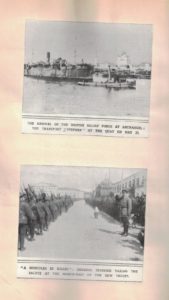
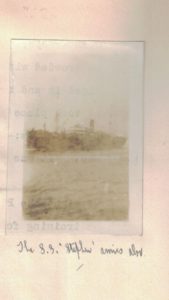
The SS Stephen arrives also
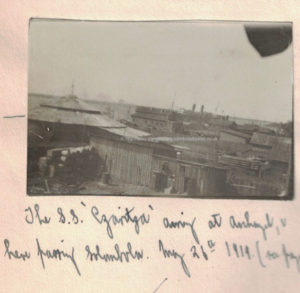
The SS Czaritza arriving at Archangel, here passing Solombola, May 26th 1919
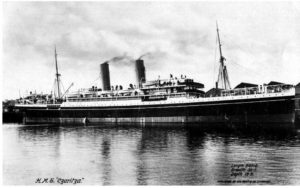
Another Glasgow built ship by the Barclay Curle Co. Launched in 1915 and slightly bigger than Czar at 6852 tons the ambiguous names of Czaritza and Tsarina appear to have both been carried during her trips to Archangel. This may account for Douglas’s spelling “Cazarina” or maybe it was just an error by the typist.
Following the Russian Intervention she was sold to the Danish Baltic-American Line and renamed Lituania. Several name changes later found her in the service of the Polish Navy. Evacuation to Dartmouth, England kept her from the clutches of the Nazis during WW2. However, she performed with a great deal of dexterity and valour during that conflict. Many ships acquired the “lucky” tag during times of conflict, surely there can have been few luckier than this. She was attacked on several occasions by the Japanese air force and in 1943 hit by a torpedo that failed to explode.
Surviving until 1950 she was, like her sister ship Czar broken up in Blyth, Northumberland.
Pierrot Troupes was the generic name given to concert parties formed to entertain troops at home and abroad.
Introduced to the British public from a French idea in the 1880s, it had become an immensely popular form of entertainment in the late 19th and early 20th centuries consisting of artists wearing what we might term clowns’ uniforms with pointed or floppy hats and wearing white faced make up. Acts sang, danced, juggled and performed comedy sketches etc.
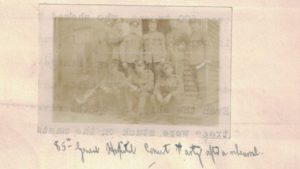
85th General Hospital Concert Party after a rehearsal
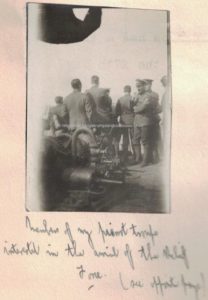
Members of the pierrot troupe interested in the arrival of the relief force.
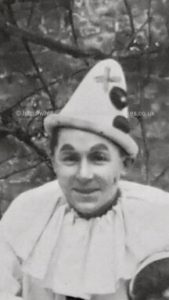
Douglas the Pierrot
Find out about our connection with Dr Page and an introduction to his diary here
24th May 1919 Saturday
Relief Coming but No Relief Yet
All material produced or reproduced here and throughout this work is the sole copyright of the author and the family of Doctor D.C.M. Page MC
“Saturday, May 24th, was a day of excitement. Flags were flying everywhere, and all the shipping was decorated with bunting. A triumphal arch was erected by the Russians in Archangel, and all this was done to celebrate the arrival of the Relief Force which did not come. Some people said that the transports were stuck in the ice in the White Sea. Certainly we were all very eager to see and greet the much talked of relief force, which Mr Churchill promised to send out in order that we poor unfortunates who had spent a dreary winter in the frozen north should proceed home forthwith. Some of us did not proceed home forthwith, as you shall soon find out.”
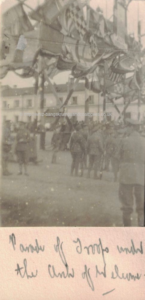
Parade of troops under the Arch of Welcome
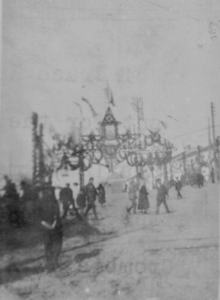
The Arch of Welcome. Built by the local Russians to welcome the relief troops being sent out from Britain.
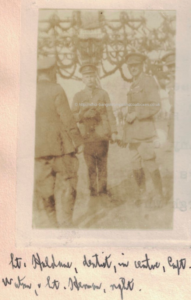
Lt. Haldane, dentist in centre. Capt. Watson left and Lt. Herman right (just in picture)
Find out about our connection with Dr Page and an introduction to his diary here
15th May 1919 Thursday
One Eye and a Fox Up The River
All material produced or reproduced here and throughout this work is the sole copyright of the author and the family of Doctor D.C.M. Page MC
“Three days afterwards the H.M.S. ‘Cyclops’, depot ship, and H.M.S. ‘Fox’ gunboat went up the river with a big number of naval ratings aboard.”
HMS Fox was a second class cruiser of a modest 4360 tons loaded with guns etc. Built in 1893 and entering service three years later she was by 1919 considered obsolete and approaching the end of her life. Although built of steel her hull was clad in both copper and wood to deter the growth of barnacles in the tropics for which she was intended. The rapid encrustation in warm water could severely affect a ship’s performance. Her duties were mainly as a show of force to those considered inferior nations and offer some kind of threat to enemies. However, it was known that she would be of little use in a sea battle. Withdrawn from service following her duties in Archangel she was scrapped in 1920.
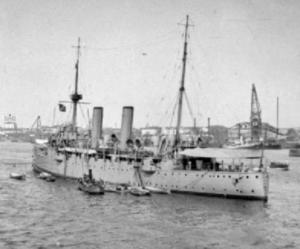
HMS Fox pictured in Archangel in 1919 (public domain)
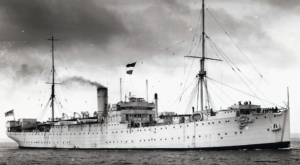
HMS Cyclops pictured in 1943 Photo by R.J. Mundy via Creative Commons https://commons.wikimedia.org/wiki/File:HMS_Cyclops_Scotland_1943ish.jpg
Whist under construction as a passenger liner the “Indrabarah” for the Liverpool based Indra Line in 1905, she was purchased by the Royal Navy for use as a depot repair and supply ship. She spent most of WW1 in Scapa Flow in service to the Grand Fleet. Decommissioned in April 1919 she was immediately reinstated and despatched to Archangel to back up the Intervention force. She remained out there until October before returning to Chatham. Nicknamed “Cycle-box”, HMS Cyclops was adapted for use as a submarine depot and then had a long period of service and survived WW2 before being scrapped in 1947.
Find out about our connection with Dr Page and an introduction to his diary here
12th May 1919 Monday
Fun in The Sergeants’ Mess
All material produced or reproduced here and throughout this work is the sole copyright of the author and the family of Doctor D.C.M. Page MC
“On Monday, May 12th, I attended, by request, a smoking concert in the sergeants’ mess. It was great fun and beer was flowing very freely! I gave them a song, much to their delight and had to repeat the dose. Our sergeants are a good lot, and know what hard work is. We heard to-day that the neck of the White Sea was choked up with ice as a result of the persistent northerly winds. As a result no boats can get up the Dwina to Archangel.”
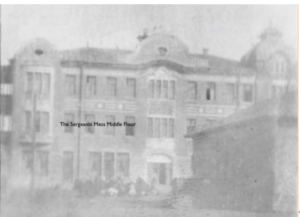
Sergeants’ Mess Middle Floor
Find out about our connection with Dr Page and an introduction to his diary here
11th May 1919 Sunday
Fifty Wounded Blighty Bound
All material produced or reproduced here and throughout this work is the sole copyright of the author and the family of Doctor D.C.M. Page MC
“On May 11th about fifty of our patients were transferred to the ‘Khalyan’ for transport to England. We were glad to see them go. They were all bad cases, and need highly skilled nursing, which we cannot give them. They were glad to go too, but were very grateful to us for all that we had done for them. Our wards were still choc-a-bloc at this time, and we were all kept very busy. Bridge at night kept us cheery, and a gramophone with some good records also helped.”
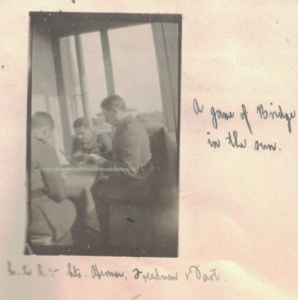
On the veranda at Solombola
A game of bridge in the sun. Left to right Lieutenants Herman, Freedman and Dart.
It would be remiss not remind readers that now exactly six months had passed since the Armistice and yet allied troops were still being killed and injured in the name of something they neither understood nor cared about. It is remarkable that although many Russians were really ambivalent about the conflict, their foreign friends were being sacrificed in their name.
Find out about our connection with Dr Page and an introduction to his diary here
2nd May 1919 Friday
At Last Men and Stores Arrive From Blighty
All material produced or reproduced here and throughout this work is the sole copyright of the author and the family of Doctor D.C.M. Page MC
“On Friday, May 2nd, two standard ships went up towards Archangel – the first since the ice break-up. They had troops and stores on board, and the sight of them did us all good. Almost daily after this boats from home came up the river.”
Movement of ships down river had begun on the 25th April following the dynamiting and ice-breaker work, but it was a slow perilous affair with massive shards of ice over twenty feet above the river bobbing about. It was only by the 2nd May that the longed for relief ships had begun to make it to Archangel.
Find out about our connection with Dr Page and an introduction to his diary here
29th April 1919 Tuesday
The Thaw Gathers Pace
All material produced or reproduced here and throughout this work is the sole copyright of the author and the family of Doctor D.C.M. Page MC
“On Tuesday, April 29th, the ice on the river began to break up. It was a wonderful sight to see the ugly, brown, swirling waters rushing down towards the White Sea carrying huge blocks of ice and masses of debris – trees, houses, and even barges. The crunching noise made by the ice was terrific. Crowds lined the river bank watching the awful spectacle. Some Russian men salved the logs as they were borne downstream on blocks of ice. These men armed with ice hooks jumped from block to block, and tied ropes to their captures. It was an exciting game to watch. By evening most of the ice had disappeared downstream, but the river was still bringing down a lot of ice. The speed with which the river broke up, and the ice disappeared seaward, was due to the fact that ice-breakers had kept the main channel open all winter, and thus prevented blocking at the bad bends and narrower parts of the river. During the afternoon the hospital ship ‘Khalyan’ passed downstream escorted by a large ice-breaker.”
The dynamiting of the Dwina, reinforced by the operations of the ice-breakers that had taken place during the month of April had helped to keep parts of the river open to some traffic. The railway that had been laid on the ice had been dismantled and it had been hoped to allow relief troops to reach Archangel. An ice-breaker was being used as a ferry to cross the river and some movement of ships that had been unable to reach the port began.
Ironside at this time reaffirms the modus operandi for the British forces out in Russia was simply an orderly withdrawal. A simple enough intention you might think but it would prove anything but.
- Further to yesterday’s submission it should be noted that Monitor M23 also arrived at Archangel on the 5th May. An M15 class vessel M23 would be similar to M25 and M27. She saw out the rest of the conflict before arriving back in the UK in November that year. She was scrapped in Fife during 1959.
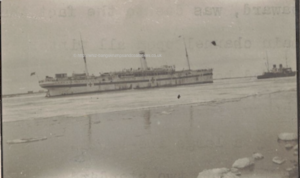
HMHS Kalyan on the River Dwina preceded by an Ice-breaker.
(Picture from the diary all rights reserved)
Find out about our connection with Dr Page and an introduction to his diary here
28th April 1919 Monday
A Honky-Tonk at the Free and Easy
All material produced or reproduced here and throughout this work is the sole copyright of the author and the family of Doctor D.C.M. Page MC
“On April 28thwe had a ‘Free and Easy’ entertainment for the staff and convalescent patients in our recreation room. Each man got two bottles of beer or stout, four packets of cigarettes, or a tin of tobacco, chocolate, toffee, cakes, biscuits, and coffee for the teetotallers. A very good musical programme was gone through, although the piano, borrowed from one of the monitors, was not very good. It was a huge success, and uplifted the men’s spirits wonderfully.”
The men were treated to a party known as a “free and easy” to lift the spirits. Part of the celebrations involved an old piano borrowed from one of the monitors stationed off Archangel. Monitors were small ships of around 540 tons whose sole purpose was to carry a large gun serving as an offshore artillery battery. Of the five that were sent out to Russia two were deployed to Archangel at this time and they were of the M15 class HMS M25 and HMS M27, so it was one of these that provided the piano for the “free and easy”. These ships had a complement of 69 men plus officers and being quite small in size would have seemed quite well populated.
M25 and M27 survived the expedition to Russia until the end of operations in September 1919 when they were both scuttled in the Dwina river after being grounded by the receding water level. They had a few skirmishes with the enemy including becoming almost grounded in the shallow summer waters of the Dwina. They were joined in the summer by M33 a slightly bigger class that had seen action at Gallipoli. M33 survived not only WW1 and Russia, but has survived to this day, despite being hit twice by enemy gunfire, the shells piercing the hull and an internal bulkhead before rattling around the interior without exploding. For those that are interested she is preserved now in dry dock at the Museum of The Royal Navy in Portsmouth.
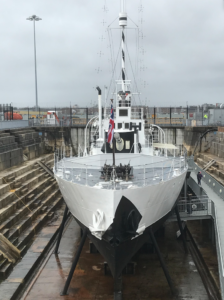
Monitor HMS M33 preserved at Portsmouth
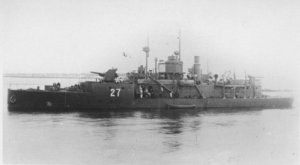
M27 Pictured on the Dwina 1919 (Public domain)
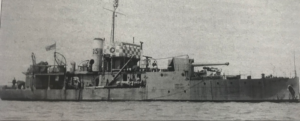
M25 as pictured in Damien Wright’s excellent book “Churchill’s Secret War with Lenin” (public domain)
Find out about our connection with Dr Page and an introduction to his diary here